There’s nothing new or unexpected in this Technorati Monster screen:
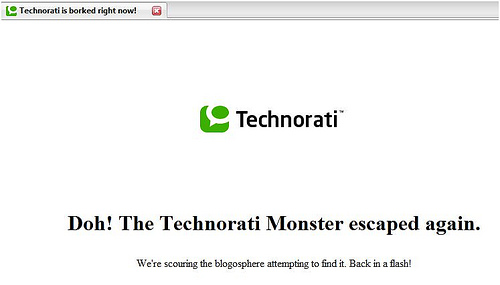
In fact I see it so often, it feels like a standard Technorati feature. Perhaps it’s time to remove “right now” from the title. Technorati is borked. (period)
Connecting the dots ...

There’s nothing new or unexpected in this Technorati Monster screen:

In fact I see it so often, it feels like a standard Technorati feature. Perhaps it’s time to remove “right now” from the title. Technorati is borked. (period)

…when whatever you’re discussing the first thought that comes to your mind is “I’ve already blogged about this” and want to quote yourself – in an offline, verbal discussion.

I haven’t updated my resume for at least 3-4 years now. (There must be some old versions floating around, as just a few days ago a recruiter solicited me for a SAP Implementation Project – she must be especially dumb, not noticing the decade-old timestamp on my SAP qualifications.) But back to resumes: I don’t need one, and neither do you.
Even in the “old days” of writing resumes any recruiter would confirm that the single best way of landing a job was through your personal network. Top Executives, genius engineers, star salesmen, well-published academics don’t ever need to look for a job: they get invited. It’s always better than knocking on the door. Or many doors.
But now Seth Godin sets the same rules even for applicants to his internship:
Having a resume begs for you to go into that big machine that looks for relevant keywords, and begs for you to get a job as a cog in a giant machine. Just more fodder for the corporate behemoth. That might be fine for average folks looking for an average job, but is that what you deserve?
If you don’t have a resume, what do you have?
How about three extraordinary letters of recommendation from people the employer knows or respects?
Or a sophisticated project they can see or touch?
Or a reputation that precedes you?
Or a blog that is so compelling and insightful that they have no choice but to follow up?
We’ve looked at the two extremes: the top 5% whose personal reputation and network carries them on, and those who can’t really have a meaningful resume, since – unlike Ben – they are barely starting their careers. But in between is the rest of us, average Johns ad Janes, who probably have some achievements, are remarkable in one way or another … if only the world knew about it! Well, that’s the point! Most of us don’t have an extensive enough personal network, or they may be geographically dispersed, or they may not be in the right position… so how to get the word out?
Blogging changes it all. If you’ve been blogging for years, you certainly did not do it with a particular job in mind; your blog is likely to be a true reflection of who you really are, what you are an expert in, your communication skills, your priorities … YOU as a whole person, not as a candidate for a specific job – the brand called You. That’s certainly better than a resume, which is likely tailored for a particular job, and let’s face it, often “cosmetically enhanced” – no wonder it ends in the waste-basket.
You don’t have a blog? Why? Don’t you know the best time to market yourself is when you don’t need it?
Tom Peters has been saying for years:
“Regardless of age, regardless of position, regardless of the business we happen to be in, all of us need to understand the importance of branding. We are CEOs of our own companies: Me Inc. To be in business today, our most important job is to be head marketer for the brand called You“
My friend and fellow Enterprise Irregular Roth Boothby argues:
“…hiring a blogger is a lower risk proposition because you have more information and a better idea of how they are going to perform.”
He should know – he got hired twice, based on his blog. By the way, I really envy Rod’s charting skills:

It’s never been easier to build that Brand Called You: if you’re still not doing it, what are you waiting for? Start your blog today!
(hat tip: BL Ochman)

Yes, it’s great to be able to download my feed items and read it on the plane without Internet connection (since I am not flying Virgin). I even “starred” some entries I want to respond to.But why can’t I mark items “read”? It’s an “online only” action – that does not make sense. When I go back online, Google Reader will perform synchronization anyway; why could it not remember “read” status and sync it?
The above rant is half a year old. I typed it up and decided not to post it. Now I am finding myself offline for a few days again, and can’t believe Google still hasn’t fixed this shortcoming.
Why is it a big deal? If you have hundreds of items in your Reader, I seriously doubt you will use Expanded View and scroll through everything. I found the only way to stay productive with Reader is to use List View, scan titles (OK, a combination of titles and author), and when all done, click “Mark all as read”. I don’t want to reprocess the same items again and again.
The error message says I can do this once I am connected again. But it’s too late, by then my Reader list will be a mix of already seen and new items. In other words, I am scr***d.
What really baffles me though is that I haven’t found any references to this problem online. Am I the only one finding this a major productivity killer? 
Update (3/14): Now that ReadBurner, a cool tool to determine the most shared items in Google Reader became the news du jur, let me just point out that you can’t mark an item ‘shared’ while offline, either. Not as frustrating as losing “read”status, just an annoyance. Google, please fix Reader!
Related posts: Unofficial ReadBurner, louisgray.com, Adam Ostrow, CenterNetworks and SheGeeks
Update (12/21/08): Google Reader Seems Buggy as Heck

Naked Conversations co-authors Robert Scoble and Shel Israel are finally co-working again, as video-bloggers @ FastCompany TV. Shel’s show will be GlobalNeighbourhoods TV (GNTV), while Robert’s is – what else? – Scoble TV.
Congrat’s and have fun! (naked or clothed ).
).
P.S. On second thought, if they plan to do a lot of Naked business together, they might invite the CEO if Zivity.
Update (1/30): Robert posted the same pic explaining that they were NOT naked. Of course not! I remember, as I was there, at the 5th TechCrunch party, which became the Naked Conversations launch party. So it’s a promo shot at a promo party – and hey, there is strong symbolism in the title, the co-authors did not get undressed just for fun (or who knows? ). They are the Naked Buddies – as in co-authors of Naked Conversations.
). They are the Naked Buddies – as in co-authors of Naked Conversations.

 Now that The Crunchies, the Internet Startup world’s equivalent of the Oscars are over, the winners announced, a lot of champagne consumed, let me go back to a few thoughts that have been on my mind throughout the whole show.
Now that The Crunchies, the Internet Startup world’s equivalent of the Oscars are over, the winners announced, a lot of champagne consumed, let me go back to a few thoughts that have been on my mind throughout the whole show.
First of all, it was nice to see so many startups recognized, meet familiar faces again, and I join the chorus in thanking TechCrunch, ReadWriteWeb, VentureBeat and GigaOm for putting the show together. Special kudos to Om Malik for coming only three weeks after his heart attack.
Second, I can’t help but think that some of the categories were .. well, almost deterministic, leaving zero chance of winning for the “little guys” lumped together with a giant. Right out of the gate, the first category, Best gadget/device: iPhone, Kindle, Ooma, Pleo, Wii. C’mon, did anyone doubt for a minute the iPhone would win? Or look at the Best mobile startup, where the finalist were AdMob, Fring, Loopt, Shozu, Twitter. Oh, please, 3 relatively unknown names against Twitter, a mega-phenomenon… 
 The other thought I’ve been pondering ever since the show is whatever happened to business software? The Crunchies were yet another proof that “enterprise isn’t sexy“: this was all about consumer-glitz, with a few startups who cater to businesses. That said, at least there was an Enterprise startup category, and I was really glad to see my friends at Zoho win it. Although I wholeheartedly believe they deserve it, this was by far not a slam-dunk category, with Zoho and 37signals, which has a religious cult-like fan-base being the two chief contestants.
The other thought I’ve been pondering ever since the show is whatever happened to business software? The Crunchies were yet another proof that “enterprise isn’t sexy“: this was all about consumer-glitz, with a few startups who cater to businesses. That said, at least there was an Enterprise startup category, and I was really glad to see my friends at Zoho win it. Although I wholeheartedly believe they deserve it, this was by far not a slam-dunk category, with Zoho and 37signals, which has a religious cult-like fan-base being the two chief contestants.
Perhaps the Zoho team felt a bit of extra satisfaction, given that 37signals originally questioned their viability, and called them copycats rather than innovators. Well, the innovation debate definitely ended a few weeks ago, when PC World picked Zoho’s 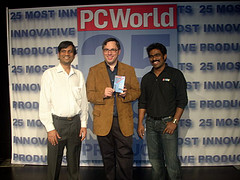 Notebook as one of the 25 Most Innovative Products of the Year. While the Crunchies were clearly a popularity contest (with over 100,000 votes) PC World’s list was compiled by professionals. This list was notably full of gadgets, and the only other software products preceding Zoho were Google Gears and the Facebook API.
Notebook as one of the 25 Most Innovative Products of the Year. While the Crunchies were clearly a popularity contest (with over 100,000 votes) PC World’s list was compiled by professionals. This list was notably full of gadgets, and the only other software products preceding Zoho were Google Gears and the Facebook API.
Back to the Crunchies, Enterprise category, 37signals and Zoho are diametric opposites in many ways: 37signals product philosophy is all about simplicity, “products that do just what you need and nothing you don’t” while Zoho believes in functional richness, and their customer service attitude is quite different, too. Yet I believe they are both good companies, and there’s a clear demand for their products, which is well proven by the hundreds of thousands of loyal customers. Neither of them are really Enterprise software companies though. 37signals caters for what they call the “Fortune 5,000,000” and Zoho clearly stated their mission to be the “IT for Small Business” – not that a subset of their portfolio, the Office Suite could not become Enterprise-ready, but for now it’s not their primary focus. And focused they are …
I think the Crunchies used the term Enterprise quite liberally – I would have called this category Business Software. Now, if the names IBM, HP, SAP, Citigroup, Boeing, BMW, Shell, McDonalds, Pfizer sound familiar , I’m sure you agree that the company who claims these and others customers is truly an Enterprise Software company. Yet Atlassian ended up in the International category, to their bad luck, as they got paired up with Netvibes. The two are apples and oranges. Atlassian is a very successful company, but the people who buy enterprise software are not the types who hang out at the Web 2.0 tech blogs or vote for the Crunchies; Atlassian stood no chance against Netvibes, with their tens of millions of individual users, all potential voters in this popularity contest.
, I’m sure you agree that the company who claims these and others customers is truly an Enterprise Software company. Yet Atlassian ended up in the International category, to their bad luck, as they got paired up with Netvibes. The two are apples and oranges. Atlassian is a very successful company, but the people who buy enterprise software are not the types who hang out at the Web 2.0 tech blogs or vote for the Crunchies; Atlassian stood no chance against Netvibes, with their tens of millions of individual users, all potential voters in this popularity contest.
What do three so different companies, Atlassian, 37signals and Zoho have in common? All three are bootstrapped, fast growing, financially successful and follow the “old-fashioned” business model of making good products and charging for it. I could not help but think of these guys while listen to the announcement of the Best Bootstrapped startup category, decided between FriendFeed, PoliticalBase, ProductWiki, Techmeme, UpNext. Or while listening to the panel discussion moderated by Dan Farber, where Matt Marshall expressed his astonishment how far the ad-based business model propelled us, and was wondering if advertising as the only business model would work in the downturn (no R-word!). If we had to pick the survivors of a potential downturn, these three companies are certainly safe candidates. The good old business model of charging for your product, which, incidentally, your customers love works wonders. 

Of course there was a lot more to the Crunchies, but it’s been all more then adequately covered, and I wanted to focus on business software now. But…well, I am a guy and guys love cars… so I have to mention the Cleantech category, won by Tesla, makers of this beautiful electric sports car. The only problem is, the car does not exist yet, release date has been pushed out repeatedly, the company had to go back for repeat funding, just fired a bunch of people, including the VP Manufacturing, Lead Engineer if the motor team… but hey, why not give them the Award and keep on dreaming (about the car). 
Update: Apparently I am not the only one questioning the rationale of some category assignments at the Crunchies; read CenterNetworks on user-generated content.

This may very well be the first LinkedIn outage I’ve caught, and it comes on the day Google’s Blogger was down, and the Technorati Monster popped up it ugly head again. Oh, well, at least this one is cute.
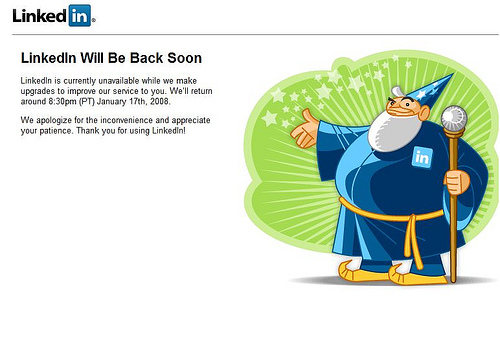

CoveritLive is supposed to change live blogging. What better opportunity to debut than Macworld? Except that I am off to a shaky start trying to watch Crunchgear’s coverage:
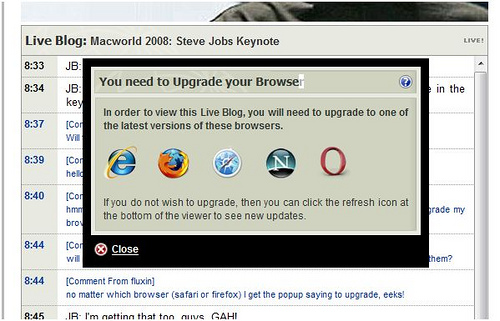
Upgrade? I’m already on the latest FireFox, thank you. 
Update: Now the CrunchGear CoveritLive page does not load at all. Coveritdead. 
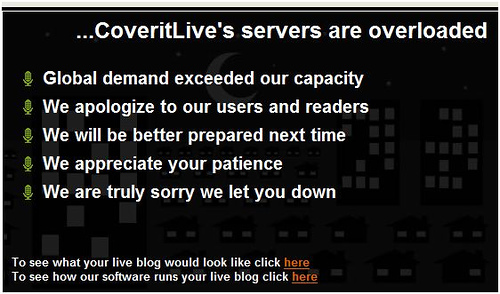
Update: Fake Steve Jobs also tried CoveritLive, then attempted to switch to Twitter… which died, too.
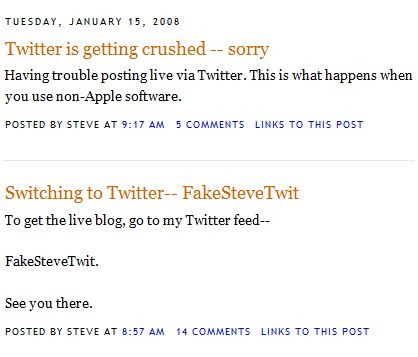
Well, at least CrunchGear’s mothership, TechCrunch stayed with the conservative, manual updates… their coverage works.
Update (1/21): Here’s a new review on CoveritLive @ReadWriteWeb. We’ll just have to wait for another major event to see it truly “live”.
Update (2/27): Jeff Nolan and Dennis Howlett praise CoveritLive.
Related posts: Mashable, mathewingram.com/work, Paul Kedrosky’s Infectious Greed, Data Center Knowledge, Furrier.org, Mashable!, Valleywag, CenterNetworks, TechCrunch.

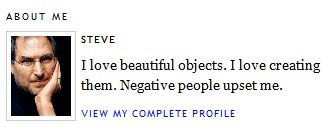 Am I the only one thinking the latest episode in the FSJ shutdown drama is not even written by The Man himself? It’s just too lengthy … not his style at all. Is there a Fake Fake Steve Jobs now?
Am I the only one thinking the latest episode in the FSJ shutdown drama is not even written by The Man himself? It’s just too lengthy … not his style at all. Is there a Fake Fake Steve Jobs now?
On the other hand, if it’s really him, could he be preparing to “retire”?
Oh, well, it was fun while it lasted.
More details at: mathewingram.com/work, Dan Blank, MacUser, Engadget, Alice Hill’s Real Tech News, Guardian Unlimited, WinExtra, ParisLemon, Slashdot, Global Neighbourhoods, Smalltalk Tidbits …, Mashable!, Scobleizer.

 I confess: I also had a captcha on my blog, in my “prior life” on blogware. In fact my defenses were so developed (or primitive?) that Zvents CEO Ethan Stock rightfully called it an obstacle course.
I confess: I also had a captcha on my blog, in my “prior life” on blogware. In fact my defenses were so developed (or primitive?) that Zvents CEO Ethan Stock rightfully called it an obstacle course.
Thankfully I have a better life (OK, just a platform) now, on WordPress, where the combination of Akismet and Spam Karma 2. provides sufficient enough spam protection so I don’t have to torture readers with such obstacle courses anymore. But I guess not all blog platforms are created equal.
Today I tried to leave a comment on Vinnie’s post, which is protected by a captcha. That would be OK (well, sort of) if only I knew it upfront. But what typically happens – and I am not picking on Vinnie, seen this on several other Typepad blogs – is that I review the comment, hit “post”, then move on to another Firefox tab (hey, even I can multitask). Later, when I come back to review the comment/close the tab, I find the captcha screen still waiting for my input. The damn thing was so slow, it did not reveal the captcha screen in when I was here before.
How to improve the captcha? Well, displaying it right on the comment entry page would be a good start… but even better, remove it entirely, replace it with some more intelligent background process (like, if I am a repeat approved commenter on this blog, chances are I am not a spammer … but I am not trying to re-invent Spam Karma logic here).
The absolute irony of the situation: you can read it all right here, on Vinnie’s blog: UI again …don’t pretty up, destroy!
P.S. Vinnie, my friend, I am not picking on you … just your platform.
Update (2/28): A hilarious collection of the 10 worst captchas.
Update (3/5): CAPTCHA is Dead, Long Live CAPTCHA! @ Coding Horror.

Publisher / Editor of CloudAve and Enterprise Irregulars.
I do most of my business blogging there, with occasional asides here. More...
Copyright © 2025 · Mindstream Child Theme on Genesis Framework · WordPress · Log in
Recent Comments